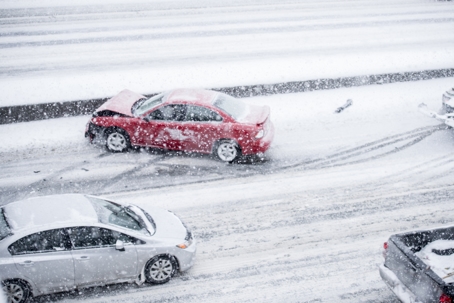Weather in East Haven often shifts faster than drivers expect. A clear afternoon can turn into a slick commute along I-95, and a calm morning can hide frost on bridges near Tweed-New Haven Airport.
These small changes have real consequences. Roughly 12 percent of crashes nationwide involve some form of adverse weather. In Connecticut, those odds rise during coastal transitions between warm air and cold ground, when moisture, wind, and road temperature work together to create hazards that are easy to underestimate.
Understanding how local weather patterns affect driving isn’t only about prevention. It also matters after a crash, when questions of liability and negligence come into play.
How Often Does Weather Contribute to Crashes Around East Haven?
East Haven’s position along the Long Island Sound means the town experiences a mix of inland and maritime weather. That combination produces several recurring risks: fog rolling in from the coast, strong crosswinds on bridges, and rapid freezing on elevated roads.
According to Connecticut Department of Transportation data, winter months account for a rise in weather-related crashes and fatalities. Yet risk spikes aren’t limited to snow season. Heavy rain and poor drainage along U.S. 1 and Route 80 can make even late-spring commutes treacherous.
Bad weather can cause conditions to rapidly change on the road. Winds gusting up to 30 mph can affect vehicle stability on exposed sections of I-95 and I-91, while clear nights with temperatures just above freezing can still allow road surfaces to dip below 32 °F — perfect conditions for invisible ice. These are the quiet dangers that catch many drivers off guard.
Which Weather Conditions Are Most Dangerous for Local Drivers?
Several patterns consistently appear in crash data and weather analyses for East Haven:
- Black Ice & Frost. Even when the air feels mild, pavement on bridges and overpasses cools faster than the ground. Drivers crossing the Quinnipiac River Bridge or the I-95 connectors near the airport may suddenly encounter ice without warning. Accident likelihood on icy roads can be four times higher than on dry roads. Some studies place the risk even higher.
- Heavy Rain & Hydroplaning. After several dry days, oil and debris build up on asphalt. When rain finally hits, that residue mixes into a slick film, making the first hour of rainfall especially dangerous. Hydroplaning can occur at speeds as low as 35 mph.
- Coastal Flooding. During high-tide rain events, low-lying roads such as Ellis Road and Hemingway Avenue can flood with one to two feet of water. Even twelve inches of moving water can carry away a car.
- High Winds. Strong gusts make it harder to maintain control, particularly for SUVs and delivery vans. Crosswinds are most intense on open stretches of highway and bridge approaches.
- Fog. Thick coastal fog reduces visibility to a few car lengths. Low-beam headlights improve visibility, while high beams reflect off moisture and make the view worse.
Why Bad Weather Doesn’t Excuse Negligent Driving
Poor weather may be a contributing factor, but it rarely absolves fault. Under Connecticut law, every motorist has a duty to drive with reasonable care under existing conditions. That means slowing below the posted speed limit when roads are wet, increasing following distance in fog, and ensuring all lights and wipers are functional.
Drivers who fail to adjust for conditions — by tailgating in heavy rain, failing to clear snow from a windshield, or using cruise control on icy pavement — can still be held liable for resulting injuries. Courts and insurance investigators often examine whether a driver’s actions were reasonable given the weather, not whether the weather alone caused the accident.
How to Drive Safely Through East Haven’s Changing Seasons
Year-round safety depends on preparation and awareness rather than quick reactions.
- Before winter: Check tire tread depth and pressure, and keep windshield washer fluid rated for freezing temperatures.
- During rain: Reduce speed by at least one-third, maintain a four to five-second following distance (longer in heavy rain), and avoid sudden braking.
- On icy mornings: Start slowly, steer gently, and avoid cruise control.
- In fog: turn on low beams, not high beams, and use road markings as a guide.
- During high winds: Grip the steering wheel firmly, especially when exiting tunnels or sheltered areas onto bridges.
Drivers should also watch local alerts through CTroads.org or state updates before traveling, as they provide live radar and road-closure information.
What to Do After a Weather-Related Crash
After ensuring everyone’s safety, drivers should:
- Call 911 for assistance and medical evaluation.
- Document the scene by taking photographs of weather conditions, skid marks, and any standing water or ice.
- Exchange information with the other driver but avoid speculation about fault.
- Seek medical attention even if injuries seem minor, since some symptoms appear later.
- Contact an East Haven car accident lawyer before dealing with insurers who might downplay the other driver’s responsibility by citing “bad weather.”
How Action Law Group Helps Victims of Weather-Related Car Accidents
After a crash, many drivers are told that the weather was to blame and that no one can be held accountable. In practice, that is rarely true. Action Law Group investigates whether another driver’s negligence contributed to the collision. We represent clients in weather-related car accidents not only in East Haven but across Connecticut, including New Haven, Bridgeport, Waterbury, and Stamford.
Our firm’s attorneys gather evidence from police reports, roadway cameras, and meteorological data, sometimes consulting experts to reconstruct the sequence of events. They negotiate with insurance companies to ensure that weather is not used as an excuse to deny fair compensation for medical bills, lost wages, and long-term recovery costs.
If you were involved in a crash during bad weather and believe negligence played a role, contact us for a free consultation. Our lawyers can review your case and explain your options.

